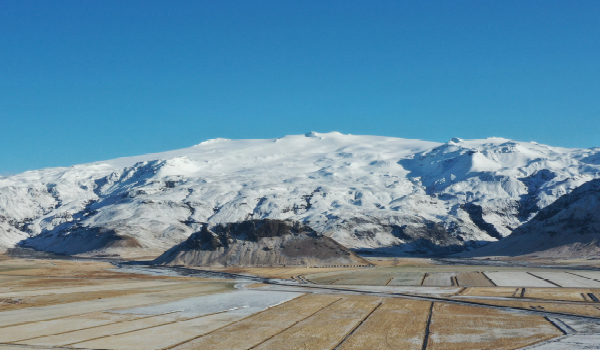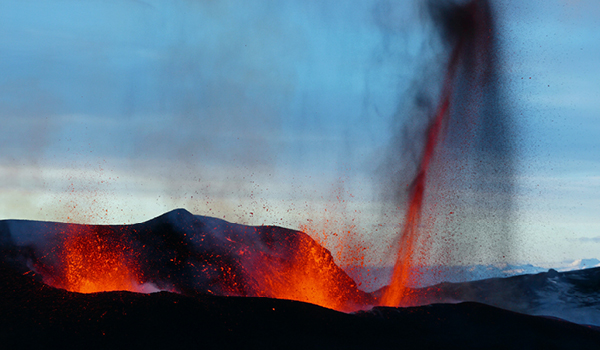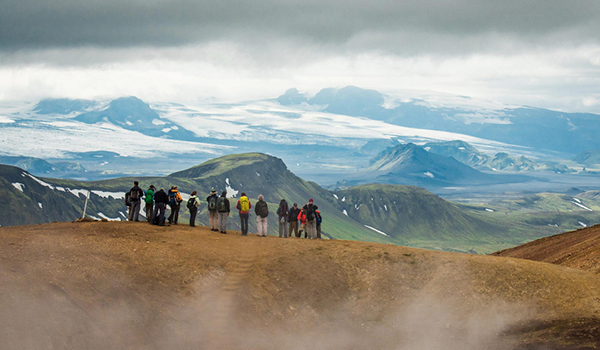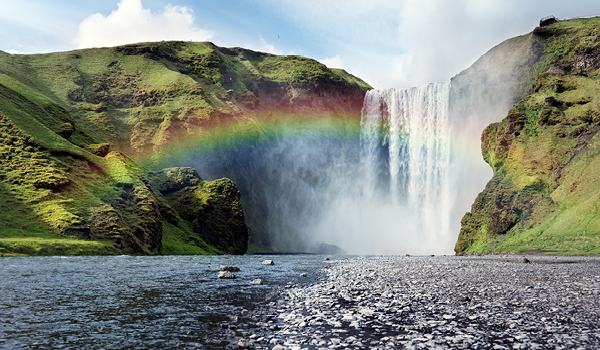Your Guide to Eyjafjallajökull Volcano and Glacier in Iceland
November 9, 2022
Your Guide to Eyjafjallajökull Volcano and Glacier in Iceland
November 9, 2022
There are over 130 active volcanoes across Iceland, but the one that sticks out in everybody’s mind has to be Eyjafjallajökull. The 2010 eruption, grounding air traffic across Europe and dominating the news, put Eyjafjallajökull in everyone’s minds. Completely covered by an ice cap and with a huge magma chamber inside, this volcano tends to get explosive when it erupts. Even when it’s dormant, there is plenty to enjoy at Eyjafjallajökull – a huge white tongue of glacier sitting in a volcanic ravine, hiking atop the frozen landscape and walking along the hiking path to discover the new craters from the 2010 eruption. Reykjavik Excursions run a number of tours along the south coast and joining one of these means you can see Eyjafjallajökull volcano in Iceland yourself. Read our complete guide to Eyjafjallajökull before embarking on your volcanic adventure.
What is Eyjafjallajökull?
The name Eyjafjallajökull translates into English as island mountain glacier, which seems pretty obvious, right? After all, it is a glacier, sitting atop a volcanic mountain in the centre of the island. The volcanic system beneath is completely covered by an ice cap, and Eyjafjallajökull perhaps sums up the phrase “the land of ice and fire” better than anything. It is one of the few stratovolcanoes in Iceland – a volcano built of alternating layers of ash and lava. A huge magma chamber lies beneath the mountain, which has resulted in a few explosive eruptions over the centuries, the most famous in living memory being in 2010.
Where is Eyjafjallajökull?
You’ll find Eyjafjallajökull, one of Iceland’s smaller ice caps, in the Eastern volcanic area of the island, along the route of the south shore. It sits north of Skógafoss and west of Mýrdalsjökull. It’s 125km from Reykjavik to Eyjafjallajökull so driving there takes around two and a half hours.
Witness the raw power of Eyjafjallajökull volcano and glacier yourself

Iceland’s south shore is home to myriad natural wonders. Waterfalls cascading from towering cliffs, ethereal rock formations on black-sanded beaches and, of course, glaciers and volcanoes. Discover every inch of this dramatic landscape on a small group tour of the south coast and Eyjafjallajökull.
The Eyjafjallajökull eruption in 2010
Since Iceland was first settled, records show that Eyjafjallajökull volcano erupted in 920, 1612 or 1613, and 1821–23. Most people associate Eyjafjallajökull with flight disruption and newsreaders struggling to pronounce the name in 2010. At the beginning of 2010, volcanic activity started rumbling beneath the surface of Eyjafjallajökull. After landslides and earthquakes, a small effusive eruption (where magma flows out of the volcano) took place on the Fimmvörðuháls hiking trail. By the 14th of April 2010, water had reached the magma chamber, resulting in explosive eruptions and a huge plume of ash billowing into the sky.
While dramatic sights of glowing magma flowing down the mountainside took place in Iceland, it was the ash cloud that affected the rest of the world. Particles of volcanic ash swept as far as central Europe, grounding flights and stopping air traffic across the continent for almost a week. Eyjafjallajökull dominated the news, and Icelanders had a chuckle as everyone tried to pronounce the word. We always thought it was easy! But clearly, we were wrong.
The eruption officially ended on the 22nd of May 2010, but Eyjafjallajökull lives on in the world’s memory as the volcano that caused a full week of travel chaos.
Find out about Iceland’s active and dormant volcanic systems

Meeting point of the North American and Eurasian plates, Iceland is a hotbed of volcanic activity. Vast magma chambers and bubbling calderas lie beneath frozen ice caps and the black-rock lava fields are iconic of the island’s landscape. Discover everything there is to know about Iceland’s volcanoes with our blog post.
How to get to Eyjafjallajökull?
As it is along the route of the south coast, it is quite easy to navigate to Eyjafjallajökull yourself if you are hiring a car. You can spot the white tongue of Eyjafjallajökull’s glacier from the Route One ring road that loops around the whole island, and there is an information point at the side of the road. Alternatively, you can get the bus from Reykjavik to Eyjafjallajökull, taking around two and a half hours.
If you want to see the site of the 2010 eruption up close, the Fimmvörðuháls hiking trail through Iceland’s highland wilderness (starting at Skogafoss), takes you past the newly-created craters of Magni and Móði.
Embarking on an organised tour from Reykjavik to Eyjafjallajökull means you don’t need to worry about navigating your own way there. You can just sit back and enjoy the sights of the south coast. This is also the best way to experience a glacier hike on Eyjafjallajökull, as the terrain can be challenging and having an experienced guide on the ice is essential.
Best time to visit Eyjafjallajökull
The natural wonders along the south coast of Iceland can be visited year-round and Eyjafjallajökull is no exception. The surface is still icy in the summer months, so you can still take a glacier hike in June, July and August. This is when the nights are short and the days are long, so you have more daylight to make the long drive to and from Reykjavik.
If you want to hike the Fimmvörðuháls trail, it’s better to visit in summer when walking conditions are better and there is less chance of the day being snowed off.
In winter, it’s possible to spot the Northern Lights above Eyjafjallajökull and glacier walks are still an option. As it is visible from the main road (Route One) around the island, it is possible to see Eyjafjallajökull even in the deepest, darkest winter. Of course, with any trip to Iceland in winter, you should be sure to pack waterproof clothes, plenty of layers and hats, scarves and gloves. For more general information on what Iceland is like each season, check out our blog post about the best time of year to visit Iceland.
Frequently asked questions about Eyjafjallajökull
We’ve rounded up some of the most popular questions about Eyjafjallajökull glacier and volcano to cover all your needs.
Is Eyjafjallajokull volcano still active?
Although (at the time of writing) there is no lava stream creeping down the side of the mountain or ash cloud pluming into the sky, Eyjafjallajökull is still considered an active volcano. In other words, it could still erupt at any time. However, as 2010 showed us, seismic activity in the area such as tremors, earthquakes and landslides can be monitored and there is plenty of warning before an eruption.
When was the last time Eyjafjallajökull erupted?
The last eruption was the famous 2010 eruption when Eyjafjallajökull’s enormous ash cloud billowed across Europe, grounding planes and making news headlines. There were no casualties during this eruption as the people of Iceland had plenty of warning. Around 500 people were evacuated from the area around Eyjafjallajökull but no homes were destroyed. Still, it was certainly dramatic enough for everyone to remember.
How do you pronounce Eyjafjallajökull?
Icelanders had a good laugh in 2010 when newsreaders across the globe struggled to pronounce Eyjafjallajökull. It was mispronounced so often that the BBC (British Broadcasting Corporation) published a guide on how to say it correctly in 2010: “Eyjafjallajökull (or Eyafallajökull) is pronounced AY-uh-fyat-luh-YOE-kuutl (-uh) , that is -ay as in day, -fy as in few, -oe as in French coeur, -uu as in boot, the -tl as in atlas. The (-uh) is "a" as in ago.” (BBC Magazine Monitor, April 2010).
So now you know how to pronounce Eyjafjallajökull, you can take a tour here without worrying!
How far did the ash from Eyjafjallajökull travel in 2010?
From satellite images, the plume of Eyjafjallajökull’s eruption in 2010 could be seen as far as 200km (around 125 miles) from the eruption site. The plume was driven southeast and across the North Atlantic Ocean to northern Europe by the prevailing winds. As the volcano sat beneath the jetstream, the ash particles affected a huge number of European countrys’ airspaces, from Scotland to Portugal, and Bulgaria to Russia.
Discover Iceland’s vast frozen plains with a glacier hike or snowmobiling session

11% of Iceland’s landscape is covered by glaciers. They flop like great white tongues through lunar-grey ravines and plug volcanic systems. Constantly moving and shifting in shape, they creak and crack, forming ice caves and tunnels. Find out more about these fascinating natural phenomena with our ultimate guide to Iceland’s glaciers.
Attractions near Eyjafjallajökull volcano
Skógafoss waterfall
Where the plateau of the Eyjafjallajökull and Katla volcanoes end, Skógafoss waterfall cascades over the cliffs like a white curtain. It is famous for its rainbows which appear when sunlight hits the waterfall’s mist. It is a popular stop along the south coast and marks the start point of the Fimmvörðuháls hiking trail. For everything you need to know about this fairytale-looking waterfall, check out our blog post all about Skógafoss.

Seljalandsfoss waterfall
You might get a sense of deja vu when you stop at Seljalandsfoss waterfall – it’s been used as the backdrop for numerous films and TV shows. Perhaps the biggest attraction for visitors is the fact that you can walk around the back of the waterfall, and admire the verdant green landscape through the cascade. Another popular stop along the south coast route, check out our ultimate guide to Seljalandsfoss waterfall before you go.
Fimmvörðuháls
For the ramblers, the Fimmvörðuháls hiking trail begins at Skógafoss, winding its way along the Skoga River and taking in myriad falls along the way (this section is known as ‘waterfall way’). Following the entire 125km trail, you’ll also walk past Eyjafjallajökull and can see the new craters, Magni and Móði, that formed after the 2020 eruption. This is one of the best ways to experience Iceland’s deserted and wild highlands in the centre of the island.
Tours to see Eyjafjallajökull volcano
We’ve talked a lot about the 2010 eruption, and you can see how the landscape has changed as a result of the eruption on the south coast and Eyjafjallajökull small group tour. It stops at the major south shore sights, like Seljalandsfoss, Skógafoss and the black-sanded beaches. What’s more, your transport for the day is a superjeep, taking you out into the most rugged terrain around Eyjafjallajökull. Reykjavik Excursions have a number of other tours that take in the natural wonders of Iceland’s south shore.
So, there should be no doubt in your mind that Eyjafjallajökull is one of Iceland’s must-see destinations. This ice cap and volcanic system is practically the embodiment of the Land of Ice and Fire after all. Now that you know all about the famous 2010 eruption and how to pronounce Eyjafjallajökull, all that’s left to do is check out our tours to see Eyjafjallajökull in Iceland and book your adventure today.
Tours in the spotlight
SOUTH COAST BLOG
Your Guide to Eyjafjallajökull Volcano and Glacier in Iceland
November 9, 2022
Your Guide to Eyjafjallajökull Volcano and Glacier in Iceland
November 9, 2022
There are over 130 active volcanoes across Iceland, but the one that sticks out in everybody’s mind has to be Eyjafjallajökull. The 2010 eruption, grounding air traffic across Europe and dominating the news, put Eyjafjallajökull in everyone’s minds. Completely covered by an ice cap and with a huge magma chamber inside, this volcano tends to get explosive when it erupts. Even when it’s dormant, there is plenty to enjoy at Eyjafjallajökull – a huge white tongue of glacier sitting in a volcanic ravine, hiking atop the frozen landscape and walking along the hiking path to discover the new craters from the 2010 eruption. Reykjavik Excursions run a number of tours along the south coast and joining one of these means you can see Eyjafjallajökull volcano in Iceland yourself. Read our complete guide to Eyjafjallajökull before embarking on your volcanic adventure.
What is Eyjafjallajökull?
The name Eyjafjallajökull translates into English as island mountain glacier, which seems pretty obvious, right? After all, it is a glacier, sitting atop a volcanic mountain in the centre of the island. The volcanic system beneath is completely covered by an ice cap, and Eyjafjallajökull perhaps sums up the phrase “the land of ice and fire” better than anything. It is one of the few stratovolcanoes in Iceland – a volcano built of alternating layers of ash and lava. A huge magma chamber lies beneath the mountain, which has resulted in a few explosive eruptions over the centuries, the most famous in living memory being in 2010.
Where is Eyjafjallajökull?
You’ll find Eyjafjallajökull, one of Iceland’s smaller ice caps, in the Eastern volcanic area of the island, along the route of the south shore. It sits north of Skógafoss and west of Mýrdalsjökull. It’s 125km from Reykjavik to Eyjafjallajökull so driving there takes around two and a half hours.
Witness the raw power of Eyjafjallajökull volcano and glacier yourself

Iceland’s south shore is home to myriad natural wonders. Waterfalls cascading from towering cliffs, ethereal rock formations on black-sanded beaches and, of course, glaciers and volcanoes. Discover every inch of this dramatic landscape on a small group tour of the south coast and Eyjafjallajökull.
The Eyjafjallajökull eruption in 2010
Since Iceland was first settled, records show that Eyjafjallajökull volcano erupted in 920, 1612 or 1613, and 1821–23. Most people associate Eyjafjallajökull with flight disruption and newsreaders struggling to pronounce the name in 2010. At the beginning of 2010, volcanic activity started rumbling beneath the surface of Eyjafjallajökull. After landslides and earthquakes, a small effusive eruption (where magma flows out of the volcano) took place on the Fimmvörðuháls hiking trail. By the 14th of April 2010, water had reached the magma chamber, resulting in explosive eruptions and a huge plume of ash billowing into the sky.
While dramatic sights of glowing magma flowing down the mountainside took place in Iceland, it was the ash cloud that affected the rest of the world. Particles of volcanic ash swept as far as central Europe, grounding flights and stopping air traffic across the continent for almost a week. Eyjafjallajökull dominated the news, and Icelanders had a chuckle as everyone tried to pronounce the word. We always thought it was easy! But clearly, we were wrong.
The eruption officially ended on the 22nd of May 2010, but Eyjafjallajökull lives on in the world’s memory as the volcano that caused a full week of travel chaos.
Find out about Iceland’s active and dormant volcanic systems

Meeting point of the North American and Eurasian plates, Iceland is a hotbed of volcanic activity. Vast magma chambers and bubbling calderas lie beneath frozen ice caps and the black-rock lava fields are iconic of the island’s landscape. Discover everything there is to know about Iceland’s volcanoes with our blog post.
How to get to Eyjafjallajökull?
As it is along the route of the south coast, it is quite easy to navigate to Eyjafjallajökull yourself if you are hiring a car. You can spot the white tongue of Eyjafjallajökull’s glacier from the Route One ring road that loops around the whole island, and there is an information point at the side of the road. Alternatively, you can get the bus from Reykjavik to Eyjafjallajökull, taking around two and a half hours.
If you want to see the site of the 2010 eruption up close, the Fimmvörðuháls hiking trail through Iceland’s highland wilderness (starting at Skogafoss), takes you past the newly-created craters of Magni and Móði.
Embarking on an organised tour from Reykjavik to Eyjafjallajökull means you don’t need to worry about navigating your own way there. You can just sit back and enjoy the sights of the south coast. This is also the best way to experience a glacier hike on Eyjafjallajökull, as the terrain can be challenging and having an experienced guide on the ice is essential.
Best time to visit Eyjafjallajökull
The natural wonders along the south coast of Iceland can be visited year-round and Eyjafjallajökull is no exception. The surface is still icy in the summer months, so you can still take a glacier hike in June, July and August. This is when the nights are short and the days are long, so you have more daylight to make the long drive to and from Reykjavik.
If you want to hike the Fimmvörðuháls trail, it’s better to visit in summer when walking conditions are better and there is less chance of the day being snowed off.
In winter, it’s possible to spot the Northern Lights above Eyjafjallajökull and glacier walks are still an option. As it is visible from the main road (Route One) around the island, it is possible to see Eyjafjallajökull even in the deepest, darkest winter. Of course, with any trip to Iceland in winter, you should be sure to pack waterproof clothes, plenty of layers and hats, scarves and gloves. For more general information on what Iceland is like each season, check out our blog post about the best time of year to visit Iceland.
Frequently asked questions about Eyjafjallajökull
We’ve rounded up some of the most popular questions about Eyjafjallajökull glacier and volcano to cover all your needs.
Is Eyjafjallajokull volcano still active?
Although (at the time of writing) there is no lava stream creeping down the side of the mountain or ash cloud pluming into the sky, Eyjafjallajökull is still considered an active volcano. In other words, it could still erupt at any time. However, as 2010 showed us, seismic activity in the area such as tremors, earthquakes and landslides can be monitored and there is plenty of warning before an eruption.
When was the last time Eyjafjallajökull erupted?
The last eruption was the famous 2010 eruption when Eyjafjallajökull’s enormous ash cloud billowed across Europe, grounding planes and making news headlines. There were no casualties during this eruption as the people of Iceland had plenty of warning. Around 500 people were evacuated from the area around Eyjafjallajökull but no homes were destroyed. Still, it was certainly dramatic enough for everyone to remember.
How do you pronounce Eyjafjallajökull?
Icelanders had a good laugh in 2010 when newsreaders across the globe struggled to pronounce Eyjafjallajökull. It was mispronounced so often that the BBC (British Broadcasting Corporation) published a guide on how to say it correctly in 2010: “Eyjafjallajökull (or Eyafallajökull) is pronounced AY-uh-fyat-luh-YOE-kuutl (-uh) , that is -ay as in day, -fy as in few, -oe as in French coeur, -uu as in boot, the -tl as in atlas. The (-uh) is "a" as in ago.” (BBC Magazine Monitor, April 2010).
So now you know how to pronounce Eyjafjallajökull, you can take a tour here without worrying!
How far did the ash from Eyjafjallajökull travel in 2010?
From satellite images, the plume of Eyjafjallajökull’s eruption in 2010 could be seen as far as 200km (around 125 miles) from the eruption site. The plume was driven southeast and across the North Atlantic Ocean to northern Europe by the prevailing winds. As the volcano sat beneath the jetstream, the ash particles affected a huge number of European countrys’ airspaces, from Scotland to Portugal, and Bulgaria to Russia.
Discover Iceland’s vast frozen plains with a glacier hike or snowmobiling session

11% of Iceland’s landscape is covered by glaciers. They flop like great white tongues through lunar-grey ravines and plug volcanic systems. Constantly moving and shifting in shape, they creak and crack, forming ice caves and tunnels. Find out more about these fascinating natural phenomena with our ultimate guide to Iceland’s glaciers.
Attractions near Eyjafjallajökull volcano
Skógafoss waterfall
Where the plateau of the Eyjafjallajökull and Katla volcanoes end, Skógafoss waterfall cascades over the cliffs like a white curtain. It is famous for its rainbows which appear when sunlight hits the waterfall’s mist. It is a popular stop along the south coast and marks the start point of the Fimmvörðuháls hiking trail. For everything you need to know about this fairytale-looking waterfall, check out our blog post all about Skógafoss.

Seljalandsfoss waterfall
You might get a sense of deja vu when you stop at Seljalandsfoss waterfall – it’s been used as the backdrop for numerous films and TV shows. Perhaps the biggest attraction for visitors is the fact that you can walk around the back of the waterfall, and admire the verdant green landscape through the cascade. Another popular stop along the south coast route, check out our ultimate guide to Seljalandsfoss waterfall before you go.
Fimmvörðuháls
For the ramblers, the Fimmvörðuháls hiking trail begins at Skógafoss, winding its way along the Skoga River and taking in myriad falls along the way (this section is known as ‘waterfall way’). Following the entire 125km trail, you’ll also walk past Eyjafjallajökull and can see the new craters, Magni and Móði, that formed after the 2020 eruption. This is one of the best ways to experience Iceland’s deserted and wild highlands in the centre of the island.
Tours to see Eyjafjallajökull volcano
We’ve talked a lot about the 2010 eruption, and you can see how the landscape has changed as a result of the eruption on the south coast and Eyjafjallajökull small group tour. It stops at the major south shore sights, like Seljalandsfoss, Skógafoss and the black-sanded beaches. What’s more, your transport for the day is a superjeep, taking you out into the most rugged terrain around Eyjafjallajökull. Reykjavik Excursions have a number of other tours that take in the natural wonders of Iceland’s south shore.
So, there should be no doubt in your mind that Eyjafjallajökull is one of Iceland’s must-see destinations. This ice cap and volcanic system is practically the embodiment of the Land of Ice and Fire after all. Now that you know all about the famous 2010 eruption and how to pronounce Eyjafjallajökull, all that’s left to do is check out our tours to see Eyjafjallajökull in Iceland and book your adventure today.